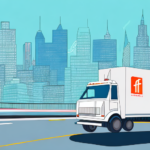Understanding Delivery Per Mile Charge
Delivery is a critical component of the logistics industry, involving the transportation of goods from one location to another. The cost of delivery varies based on factors such as distance, weight, size, and mode of transportation. One prevalent pricing model in the delivery sector is the Delivery Per Mile Charge (DPMC). This article delves into the intricacies of DPMC, exploring its mechanism, advantages, disadvantages, and its role in the evolving logistics landscape.
How Delivery Per Mile Charge Works
DPMC is a pricing strategy where delivery charges are calculated based on the distance between the pickup and delivery points. Carriers set a fixed rate per mile, which can vary depending on the carrier, type of goods, and transportation mode. The fundamental principle is straightforward: the longer the distance, the higher the delivery cost.
For example, if a carrier charges $2 per mile and the delivery distance is 150 miles, the total cost would be $300. This model offers transparency, allowing customers to easily estimate delivery costs based on distance. Additionally, it encourages carriers to optimize routes, promoting efficiency and reducing fuel consumption.
Advantages of DPMC
- Transparency: Clear understanding of costs based on distance.
- Predictability: Easier budgeting and cost forecasting for businesses.
- Efficiency: Incentivizes carriers to choose the most direct routes.
Disadvantages of DPMC
- Limited Flexibility: Does not account for factors like package weight or size.
- Minimum Fees: May not be cost-effective for short-distance deliveries.
- Additional Charges: Potential for extra fees such as fuel surcharges or tolls.
Why Companies Adopt Delivery Per Mile Charge
Companies favor DPMC due to its simplicity and clarity. By basing charges on distance, businesses can easily incorporate delivery costs into their pricing structures, ensuring profitability. Additionally, DPMC allows for straightforward comparisons between different carriers, facilitating informed decision-making.
Moreover, DPMC aligns with sustainability goals by encouraging carriers to minimize travel distances, thereby reducing fuel consumption and lowering the carbon footprint. According to a report by the U.S. Department of Energy, optimizing delivery routes can significantly decrease greenhouse gas emissions, supporting eco-friendly business practices.
Calculating Delivery Per Mile Charge
Calculating DPMC is straightforward. The formula is:
DPMC = Distance (miles) × Rate per Mile
For instance, with a delivery distance of 200 miles and a rate of $1.75 per mile, the total delivery cost would be:
200 miles × $1.75/mile = $350
It's essential to consider additional fees that may apply, such as fuel surcharges, tolls, or costs for oversized packages. Always consult with the carrier to ensure all potential charges are accounted for in the calculation.
Factors Influencing Delivery Per Mile Charges
Several elements can impact the cost of DPMC:
- Type of Goods: Fragile or hazardous materials may incur higher fees due to the need for special handling.
- Shipment Weight: Heavier shipments require more resources, increasing costs.
- Transportation Mode: Air freight typically costs more per mile than ground transportation.
- Delivery Urgency: Expedited deliveries may carry premium charges.
- Geographical Challenges: Deliveries to remote or hard-to-access areas may be more expensive.
Understanding these factors can help businesses anticipate delivery costs and negotiate better rates with carriers.
Negotiating Delivery Per Mile Charges
Effective negotiation of DPMC can lead to significant cost savings. Here are some best practices:
- Understand Your Needs: Clearly define shipment sizes, frequencies, and delivery requirements.
- Research Market Rates: Compare rates from multiple carriers to understand the standard pricing.
- Leverage Volume: Higher shipment volumes can provide leverage for discounted rates.
- Discuss Additional Fees: Ensure all potential extra charges are transparent and agreed upon upfront.
- Consider Long-Term Contracts: Committing to long-term agreements can secure more favorable rates.
By approaching negotiations with clarity and data, businesses can establish mutually beneficial agreements with carriers.
Alternatives to Delivery Per Mile Charge
While DPMC is widely used, several alternative pricing models exist:
- Delivery Per Weight Charge: Costs are based on the shipment's weight.
- Delivery Per Volume Charge: Pricing depends on the shipment's size or volume.
- Flat Rate Shipping: A fixed fee regardless of distance or shipment size.
- Subscription-Based Models: Customers pay a recurring fee for unlimited deliveries.
Each model has its advantages and is suitable for different business needs. For example, subscription-based models offer predictability for regular deliveries, while flat rates simplify billing for consistent shipment sizes.
Best Practices for Managing Delivery Per Mile Charges
To effectively manage DPMC, businesses should adopt the following strategies:
- Implement a Tracking System: Utilize software to monitor shipments and associated costs in real-time.
- Regularly Review Invoices: Conduct frequent audits to identify and rectify billing discrepancies.
- Maintain Carrier Relationships: Building strong partnerships can lead to better rates and services.
- Stay Informed on Industry Trends: Keeping up with changes can help anticipate cost fluctuations and adapt strategies accordingly.
Adhering to these practices ensures cost efficiency and enhances overall delivery operations.
Future Trends in Delivery Pricing
The delivery industry is evolving, with several emerging trends shaping pricing models:
- Dynamic Pricing: Utilizing algorithms to adjust prices based on real-time demand and supply conditions.
- Subscription Services: Offering customers fixed-rate plans for regular deliveries, enhancing predictability.
- Integration of Technology: Advanced tracking and route optimization tools are making delivery processes more efficient.
- Emphasis on Sustainability: Green logistics practices are influencing pricing strategies to reflect eco-friendly operations.
Businesses that adapt to these trends can gain a competitive edge, offering more flexible and sustainable delivery options to their customers.
Common Misconceptions About Delivery Per Mile Charges
There are several misunderstandings surrounding DPMC:
- DPMC is Always More Expensive: This isn't necessarily true. With proper negotiation, DPMC can be cost-effective, especially for long-distance deliveries.
- DPMC Only Applies to Long-Distance Shipping: DPMC is used for both short and long-distance deliveries, offering transparency in all scenarios.
- DPMC Neglects Other Cost Factors: While DPMC is based on distance, additional fees for weight, size, or special handling can be incorporated as needed.
Understanding the true nature of DPMC allows businesses to make informed decisions and avoid unnecessary costs.
Conclusion
Delivery Per Mile Charge is a fundamental pricing model in the logistics industry, offering transparency and predictability. While it has its advantages, such as simplicity and efficiency, it's essential to consider its limitations and explore alternative models when appropriate. By staying informed about industry trends and implementing best practices, businesses can optimize their delivery strategies, ensuring cost-effectiveness and customer satisfaction.




















